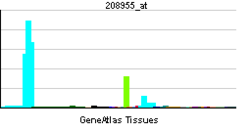- DUT (gene)
-
DUTP pyrophosphatase, also known as DUT, is an enzyme which in humans is encoded by the DUT gene.[1]
Function
This gene encodes an essential enzyme of nucleotide metabolism. The encoded protein forms a ubiquitous, homotrimeric enzyme that hydrolyzes dUTP to dUMP and pyrophosphate. This reaction serves two cellular purposes: providing a precursor (dUMP) for the synthesis of thymine nucleotides needed for DNA replication, and limiting intracellular pools of dUTP. Elevated levels of dUTP lead to increased incorporation of uracil into DNA, which induces extensive excision repair mediated by uracil glycosylase. This repair process, resulting in the removal and reincorporation of dUTP, is self-defeating and leads to DNA fragmentation and cell death. Alternative splicing of this gene leads to different isoforms that localize to either the mitochondrion or nucleus. A related pseudogene is located on chromosome 19.[1]
References
Further reading
- Persson R, Cedergren-Zeppezauer ES, Wilson KS (2002). "Homotrimeric dUTPases; structural solutions for specific recognition and hydrolysis of dUTP.". Curr. Protein Pept. Sci. 2 (4): 287–300. doi:10.2174/1389203013381035. PMID 12369926.
- Ladner RD (2002). "The role of dUTPase and uracil-DNA repair in cancer chemotherapy.". Curr. Protein Pept. Sci. 2 (4): 361–70. doi:10.2174/1389203013380991. PMID 12374095.
- McIntosh EM, Ager DD, Gadsden MH, Haynes RH (1992). "Human dUTP pyrophosphatase: cDNA sequence and potential biological importance of the enzyme.". Proc. Natl. Acad. Sci. U.S.A. 89 (17): 8020–4. doi:10.1073/pnas.89.17.8020. PMC 49847. PMID 1325640. http://www.pubmedcentral.nih.gov/articlerender.fcgi?tool=pmcentrez&artid=49847.
- Strahler JR, Zhu XX, Hora N, et al. (1993). "Maturation stage and proliferation-dependent expression of dUTPase in human T cells.". Proc. Natl. Acad. Sci. U.S.A. 90 (11): 4991–5. doi:10.1073/pnas.90.11.4991. PMC 46639. PMID 8389461. http://www.pubmedcentral.nih.gov/articlerender.fcgi?tool=pmcentrez&artid=46639.
- Ladner RD, McNulty DE, Carr SA, et al. (1996). "Characterization of distinct nuclear and mitochondrial forms of human deoxyuridine triphosphate nucleotidohydrolase.". J. Biol. Chem. 271 (13): 7745–51. doi:10.1074/jbc.271.13.7745. PMID 8631816.
- Ladner RD, Carr SA, Huddleston MJ, et al. (1996). "Identification of a consensus cyclin-dependent kinase phosphorylation site unique to the nuclear form of human deoxyuridine triphosphate nucleotidohydrolase.". J. Biol. Chem. 271 (13): 7752–7. doi:10.1074/jbc.271.13.7752. PMID 8631817.
- Mol CD, Harris JM, McIntosh EM, Tainer JA (1996). "Human dUTP pyrophosphatase: uracil recognition by a beta hairpin and active sites formed by three separate subunits.". Structure 4 (9): 1077–92. doi:10.1016/S0969-2126(96)00114-1. PMID 8805593.
- Chu R, Lin Y, Rao MS, Reddy JK (1996). "Cloning and identification of rat deoxyuridine triphosphatase as an inhibitor of peroxisome proliferator-activated receptor alpha.". J. Biol. Chem. 271 (44): 27670–6. doi:10.1074/jbc.271.44.27670. PMID 8910358.
- Cohen D, Heng HH, Shi XM, et al. (1997). "Assignment of the human dUTPase gene (DUT) to chromosome 15q15-q21. 1 by fluorescence in situ hybridization.". Genomics 40 (1): 213–5. doi:10.1006/geno.1996.4540. PMID 9070952.
- Ladner RD, Caradonna SJ (1997). "The human dUTPase gene encodes both nuclear and mitochondrial isoforms. Differential expression of the isoforms and characterization of a cDNA encoding the mitochondrial species.". J. Biol. Chem. 272 (30): 19072–80. doi:10.1074/jbc.272.30.19072. PMID 9228092.
- Ladner RD, Lynch FJ, Groshen S, et al. (2000). "dUTP nucleotidohydrolase isoform expression in normal and neoplastic tissues: association with survival and response to 5-fluorouracil in colorectal cancer.". Cancer Res. 60 (13): 3493–503. PMID 10910061.
- Fiser A, Vértessy BG (2001). "Altered subunit communication in subfamilies of trimeric dUTPases.". Biochem. Biophys. Res. Commun. 279 (2): 534–42. doi:10.1006/bbrc.2000.3994. PMID 11118321.
- Pugacheva EN, Ivanov AV, Kravchenko JE, et al. (2002). "Novel gain of function activity of p53 mutants: activation of the dUTPase gene expression leading to resistance to 5-fluorouracil.". Oncogene 21 (30): 4595–600. doi:10.1038/sj.onc.1205704. PMID 12096336.
- Strausberg RL, Feingold EA, Grouse LH, et al. (2003). "Generation and initial analysis of more than 15,000 full-length human and mouse cDNA sequences.". Proc. Natl. Acad. Sci. U.S.A. 99 (26): 16899–903. doi:10.1073/pnas.242603899. PMC 139241. PMID 12477932. http://www.pubmedcentral.nih.gov/articlerender.fcgi?tool=pmcentrez&artid=139241.
- Tinkelenberg BA, Fazzone W, Lynch FJ, Ladner RD (2003). "Identification of sequence determinants of human nuclear dUTPase isoform localization.". Exp. Cell Res. 287 (1): 39–46. doi:10.1016/S0014-4827(03)00048-X. PMID 12799180.
- Gerhard DS, Wagner L, Feingold EA, et al. (2004). "The status, quality, and expansion of the NIH full-length cDNA project: the Mammalian Gene Collection (MGC).". Genome Res. 14 (10B): 2121–7. doi:10.1101/gr.2596504. PMC 528928. PMID 15489334. http://www.pubmedcentral.nih.gov/articlerender.fcgi?tool=pmcentrez&artid=528928.
- Studebaker AW, Lafuse WP, Kloesel R, Williams MV (2005). "Modulation of human dUTPase using small interfering RNA.". Biochem. Biophys. Res. Commun. 327 (1): 306–10. doi:10.1016/j.bbrc.2004.12.021. PMID 15629463.
PDB gallery Categories:- Human proteins
- Chromosome 15 gene stubs
Wikimedia Foundation. 2010.





